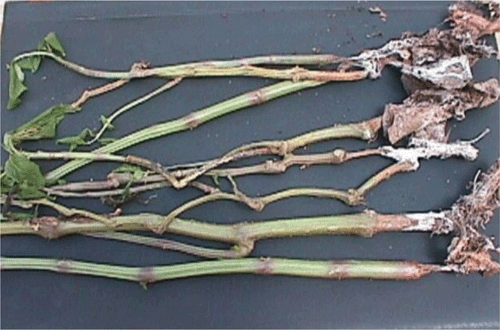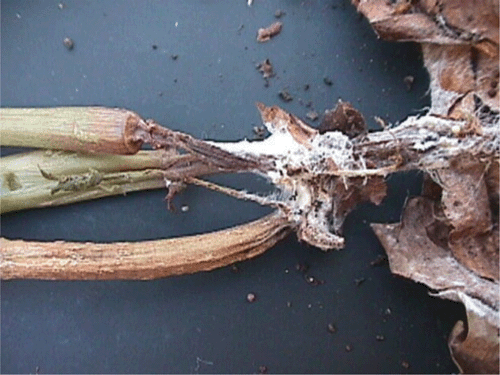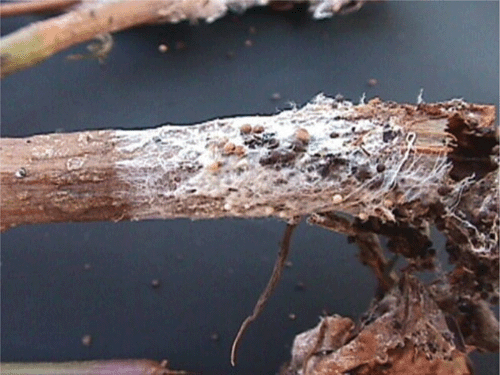Sclerotium rolfsii causing collar dry rot on Impatiens walleriana in Argentina
S. M. Wolcan A B C and P. J. Grego AA Centro de Investigaciones de Fitopatología, Facultad de Ciencias Agrarias y Forestales, 60 y 119, 1900 – La Plata, Argentina.
B Comisión de Investigaciones Científicas de la Provincia de Buenos Aires, 526 (10 y 11), 1900 – La Plata, Bs. As., Argentina.
C Corresponding author. Email: swolcan@speedy.com.ar
Australasian Plant Disease Notes 4(1) 54-55 https://doi.org/10.1071/DN09022
Submitted: 5 January 2009 Accepted: 20 April 2009 Published: 1 June 2009
Abstract
Sclerotium rolfsii is recorded for the first time causing collar dry rot on Impatiens walleriana (Balsaminaseae) in Argentina.
Busy lizzie (Impatiens walleriana) is a popular worldwide potted or bedding ornamental plant. It is the main commercial flowering potted plant grown in Buenos Aires and Córdoba provinces in Argentina (Morisigue and Villareal 2003). In December 2007, a severe basal rot was observed on plants growing in gardens in La Plata (Buenos Aires). The first symptoms appeared as drooping of leaves and rapid wilting. Plants also showed dry rot at the collar region, with contracted and blackish necrosis of the basal stem, and they finally died (Figs 1 and 2). White and fluffy mycelial growth was observed on the base of the stems and on the soil surrounding the plants. Numerous small brown spherical sclerotia, 0.5–2.0 mm in diameter, developed on the mycelia (Fig. 3). In order to identify the causal agent of the disease isolations were performed from basal stem and sclerotia. The fungus produced a septate mycelium with clamp connections and numerous whitish, tan to brown sclerotia (0.5–2.0 mm in diameter) on potato dextrose agar.

|

|

|
Based on morphological and cultural characteristics (Punja and Rahe 1992), the fungus was identified as Sclerotium rolfsii Sacc.
Pathogenicity of S. rolfsii isolates from I. walleriana was confirmed on six plants growing in 10 cm diameter plastic pots filled with natural soil. Inoculum was produced by culturing the fungus for 10 days at 25°C in Petri dishes containing autoclaved moistened rice. Inoculum was mixed with the soil near the roots and crown areas at 4 : 100 (v : v) rate. Three non-inoculated plants served as control. After inoculation, the plants were covered with a polyethylene bag for 72 h and kept at temperatures between 25°C and 27°C. Typical disease symptoms appeared in all inoculated plants within 12–16 days of inoculation. White mycelium and sclerotia were produced on the stem base and soil surface. Non-inoculated controls remained symptomless and S. rolfsii was reisolated from infected plants.
Sclerotium rolfsii is a cosmopolitan pathogen that has a wide host range and includes many field, vegetable and ornamental crops (Punja and Rahe 1992). It may infect any part of the plants, but it is frequently found on stems and leaves near the soil (Chase 1997). The disease is favoured by moist soil rich in organic matter and warm temperatures. Sclerotium rolfsii was reported on I. walleriana in the USA (Farr et al. 2008) and Philippines (Dizon and Pimentel 1993).
This is the first report of basal dry rot caused by S. rolfsii on I. walleriana in Argentina.
Dizon TO, Pimentel RB
(1993) Phytopathological note: Impatiens sultanii: host of Sclerotium rolfsii and Meloidgyne incognita. Philippine Phytopathology 29, 101–102.



